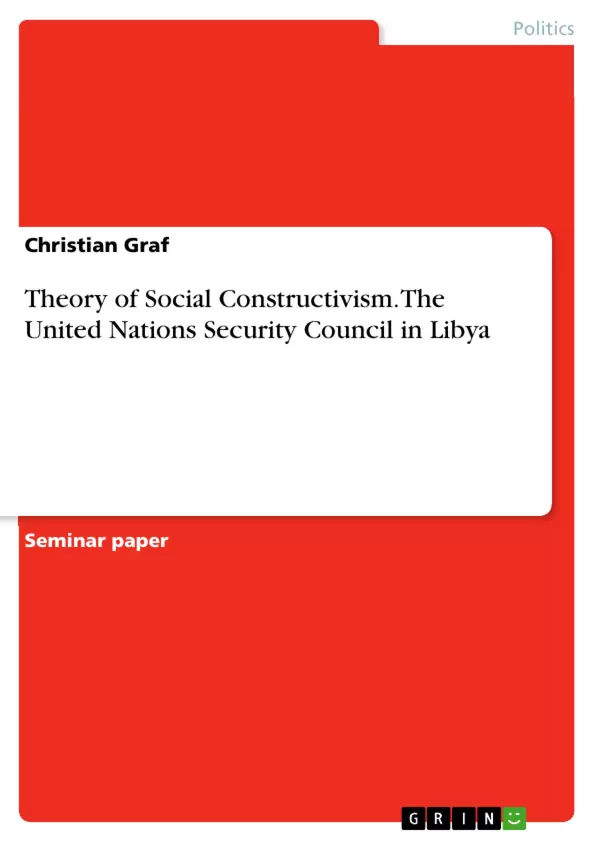The United Nations (UN) in international relations is considered to be a supranational organization. Currently the UN consist of 193 Member States and it stresses out four main purposes, which are maintaining peace and security, developing friendly relations amongst states, helping states to work together and being a centre for harmonizing the actions of nations (cf. www.un.org/en/aboutun). Additionally the UN is seen as a collective security system, which offers states to settle down any disputes and for solving social, economic, humanitarian and ecological problems on international level (cf. Gareis/Varwick 2006: 85). According to this purposes, the UN has acted and authorized multilateral interventions in many states, which were affected by conflicts. The Libyan conflict in 2011, as an example, was one of the cases where the UN has responded to. The actions and the multilateral intervention in Libya leaves questions. How does the UN shape the behavior of its Member States and why does the UN act in general? The theory of social constructivism by Alexander Wendt, can provide an explanation to these questions. The theory defines balances of power between states and explains the behavior of states. Furthermore it claims that international relations are social and the international system is constituted by ideas (cf. Jackson/Sorensen 2006: 162). But the main question which shall be discussed in this term paper is therefore: „How can the theory of social constructivism explain the actions by the United Nations Security Council in Libya?“
First of all core assumptions of social constructivism has to be discussed in order to explain further analysis of this term paper. After the illustration of the core assumptions of social constructivism, the powers and functions of the UN Security Council shall be described, because the Security Council, as one of the most important main body of the UN, is the only executive body that act regarding any threat of peace and security. Thereafter the situation in Libya, as the empirical example have to be mentioned. What exactly happened in Libya and what did the UN especially the Security Council do? Altogether with the core assumptions of social constructivism, the theoretical knowledge of the Security Council and the information of the Libyan conflict, the main question shall be answered. At the end the conclusion shall summarize the term paper´s outcome of the analysis.
Inhaltsverzeichnis (Table of Contents)
- Introduction
- Theoretical frameworks
- Core assumptions of social constructivism
- Powers and functions of the UN Security Council
- Empirical Example
- Multilateral intervention in Libya
- Explaining actions in Libya by means of social constructivism
- Conclusion
Zielsetzung und Themenschwerpunkte (Objectives and Key Themes)
This term paper aims to explain the actions of the United Nations Security Council in Libya through the lens of social constructivism. It delves into the theory's core assumptions and explores how these assumptions can be applied to understand the UN's role in international relations. The paper also analyzes the powers and functions of the Security Council and examines the specific situation in Libya, including the UN's involvement in the 2011 conflict. The key themes explored in this paper include:- The role of anarchy in the international system
- The concept of social construction and its influence on state behavior
- The importance of ideas and shared beliefs in shaping international relations
- The relationship between state identity, interests, and the international system
- The role of the UN Security Council in maintaining international peace and security
Zusammenfassung der Kapitel (Chapter Summaries)
Introduction
The introduction establishes the context for the paper, discussing the role of the United Nations in international relations and highlighting the significance of the Libyan conflict as a case study. The author introduces the main question of the paper: How can the theory of social constructivism explain the actions of the United Nations Security Council in Libya?Theoretical frameworks
Core assumptions of social constructivism
This section outlines the core assumptions of social constructivism, focusing on the idea that interaction between states in the international system is characterized by anarchy. The section explores the implications of anarchy for state behavior and introduces the concepts of self-help systems, the lack of trust among states, and the role of ideas and shared beliefs in shaping state identities and interests.Powers and functions of the UN Security Council
This section delves into the powers and functions of the UN Security Council, highlighting its role as the UN's primary body for maintaining international peace and security. It explores the Security Council's authority to act in situations of conflict and its potential to influence the behavior of member states.Empirical Example
Multilateral intervention in Libya
This section provides an overview of the Libyan conflict in 2011, focusing on the events that led to the UN Security Council's intervention. It details the actions taken by the Security Council and examines the context in which these actions took place.Explaining actions in Libya by means of social constructivism
This section applies the theoretical framework of social constructivism to explain the UN Security Council's actions in Libya. It explores how the theory can be used to understand the motivations behind the intervention and the impact of the Council's actions on the Libyan situation.Schlüsselwörter (Keywords)
The key terms and focus areas of this term paper are: social constructivism, anarchy, state behavior, UN Security Council, international relations, international peace and security, multilateral intervention, Libyan conflict, state identity, shared beliefs, ideational structures, self-help system, cooperative security system.- Quote paper
- Christian Graf (Author), 2014, Theory of Social Constructivism. The United Nations Security Council in Libya, Munich, GRIN Verlag, https://www.grin.com/document/278804



